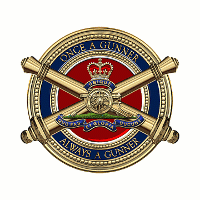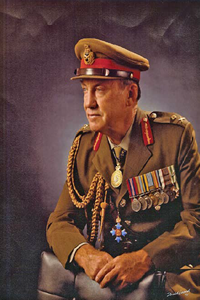| |
|
|
|
|
| |
|
|
|
|
| |
|
|
|
|
| |
|
AUSTRALIAN GUNNER
OBITUARY RESOURCE
|
|
|
| |
|
|
|
|
| |
|
|
|
|
| |
| |
| |
|
 |
|
|
| |
| |
Major General John Dennis Stevenson
AO, CBE (Retd) |
|
|
| |
|
|
|
| |
|
Provided by Colonel Arthur Burke, OAM (Retd)
Colonel Commandant Northern Region
|
|
| |
| Printed Version |
| |
 |
|
Major General John Dennis Stevenson AO CBE (Retd) passed away on 30th July 2008 following some nine months of failing health.
This tribute is an amalgam of a formally recorded interview which I had with General John in 1998 and the masterly eulogy which his son-in-law, Geoffrey Nettle delivered at the celebration of John Stevenson’s life on 6th August. To reduce almost 83 years of a very active life down to an acceptable size for publishing has been a daunting task. To comply, I have concentrated more on the Gunner aspects of his 40-year military career.
From birth in Melbourne on 13th August 1925, John Stevenson was destined to be in the Army. His father, Colonel George Stevenson had served with distinction in the Boer War, had been appointed a Companion of the Order of St Michael and St George (CMG) for his service at Gallipoli and a Companion of the Distinguished Service Order (DSO) for achievements in France during the Great War. John completed his secondary education at the Geelong Church of England Grammar School in 1942 when the Second World War was at full volume in both Europe and the South-West Pacific. He wanted to enlist immediately.
However, at this father’s insistence, John entered the Royal Military College, Duntroon for the three-year war course. With scholastic achievements as a dux in Latin, first in class in mathematics and a good performer in cricket, Australian Rules and the 880 in athletics, John enjoyed life at Duntroon—especially the relative barracks luxury and delicious meals compared with those at his former boarding school. |
Aussie Rules were not part of the Royal Military College curriculum at that time—rugby ruled. John Stevenson became a formidable player, earning his lifelong nickname of ‘Punchy’ for his method of softening up the opposition in the scrum at the breakdown. So much did John embrace this code that he captained the Melbourne Rugby Union Football Club to a premiership win in 1954 and later coached the Australian Capital Territory rugby union team, now the ACT Brumbies. His support for Army rugby was legendry.
Graduating into Artillery in December 1946 and too late for active service, Lieutenant Stevenson, along with classmates John Salmon, Dick Cubis and Brian Loveridge joined A Field Battery with the British Commonwealth Occupation Force in Japan. Returning to Australia with the battery at the end of 1948, John began a number of courses at the School of Artillery which led to his selection for the Long Observation Course at Larkhill in England. Despite its name, this was predominantly a series of locating courses followed by an attachment to the British 7th Armoured Divisional Locating Battery in Germany.
On return to Australia, Captain John was posted to the composite field / embryo locating / light anti-aircraft 1st Field Regiment which was spread between Middle and North Heads in Sydney. He became the inaugural battery commander of 104th Locating Battery before being sent to Korea, attached to the Headquarters 1st Commonwealth Division.
On return to Australia in 1953, John was appointed the adjutant/quartermaster of 10th Field Regiment on the Mornington Peninsula, Victoria. Despite the massive influx of 18 to 20 year olds from the 1950s’ National Service Scheme filling out the unit’s manning, John made time to pursue his passion for rugby, joined the Melbourne club at South Yarra and captained their premiership win in 1954.
The adjutant/quartermaster’s job must have been relatively easy in those days, for Captain John also found time to woo a young nursing sister from western Queensland who had been introduced by his RMC classmate, John Salmon. John Stevenson married Vivienne Ann Cotton in Brisbane on 6 July 1955 and began a 53 year union, ended only by his passing. Geoff Nettle described the next few years as ‘a fruitful union—for with the rapid fire accuracy of which any member of the Artillery would be proud, by 1958 he with Ann had brought forth three daughters, Jenny, Wendy and Suzie’.
The Stevensons’ first married accommodation was at Captain John’s next posting—the Royal Military College, Duntroon. Then Staff Cadet John Bullen describes Stevo’s priorities as being ‘our instructor in Rugby and our coach in Artillery’. This posting prepared John nicely for Staff College at Fort Queenscliff, Victoria in 1958 which, in turn, qualified him to become the Brigade Major (BM) at Headquarters Northern Command, Brisbane. All this happened, remember, whilst producing and caring for three young daughters.
Finally, it was time for Major Stevenson to return to the Gunners and on the opening day of the fledgling 4th Field Regiment at Wacol, 4 May 1960, he marched-in as the second-in-command to John ‘Happy Jack’ Studdert. As if Ann was not busy enough at this time, John invited his new commanding officer and the adjutant, Pat Gowans to dinner and a bed at their Bardon married quarter that night because the Officers’ Mess was not yet functioning. But this was typical of the warm hospitality and strong friendships which the Stevensons established throughout their life together and Ann merely took it in her stride.
These were tough and trying times as the new unit was raised from scratch. Nevertheless, with his dedication to working hard and playing hard, ‘Punchy’ established the beginnings of a unit rugby team and with few other service teams available, played his side with quite pleasing results in local civvy competitions.
Twelve months later, Major John not only completed his Tactics 5 course for promotion at the Jungle Training Centre, Canungra, but was then retained as a member of the staff. With his continued short posting cycle, but next with the carrot of promotion to lieutenant colonel, he was then appointed the General Staff Officer Grade One in the Directorate of Military Training at Army Headquarters, Canberra. This was June 1962 and with the look forward of RAAHC
a two-year posting, Ann and John purchased their first house in Campbell. Was this stability at last?
On 9th June 1964, Lieutenant Colonel John Stevenson took over the reins of command of 4th Field Regiment at Wacol from Joe Hooton who was off to the US Armed Forces Staff College. The new CO admitted his technical and tactical field gunner experience within the new Pentropic Division organisation’s modus operandi was limited. 105th Battery had been kept up to strength as the priority force plan artillery unit, but this had been at the expense of the 101st Battery which had returned from Malaysia in 1963 and then suffered the loss on posting of most of its key personnel and many of its gunners. John’s superiors in both artillery and command headquarters imposed unrealistic pressures to man two batteries for field exercises.
John’s leadership and diplomacy were tried to their fullest for the next 18 months, but with the experienced Majors Craig Beck and Bill Silverstone in the unit, he successfully transitioned it from a peacetime Pentropic organisation to a light-scaled Tropical Warfare establishment. The final test was launching 105th Field Battery as the first Royal Australian Artillery unit to serve in the Vietnam War. By Stevenson’s own admission, he ‘loaded’ 105th Battery at the expense of 101st breaking up trained teams within the 105th because of the urgency and short notice of this launch. Nevertheless, he directed some very realistic final testing exercises which stood Peter Tedder’s 105th in good stead in Vietnam.
Just when John’s command including the newly raised 108th Field Battery was settling down, he was posted back to Canberra as the Assistant Military Secretary in early 1966. He never returned to a Gunner appointment for the remainder of his fulltime career as higher level command and staff appointments now took control of his life. A benefit of this was stability for Ann and the girls in their Canberra home for the next six years. John was posted to Vietnam to take command of the 1st Australian Logistic Support Group from his Royal Military College classmate and life-long friend, Ian Gilmore. When this position was raised to a colonel’s appointment, John was promoted and remained in command. In recognition of his exceptional service in this role, John Stevenson was appointed a Commander of the Order of the British Empire (CBE) in the 1970 Queen’s Birthday Honours List.
Colonel Stevenson returned to Canberra as the Deputy Director of Military Plans in January 1970. Almost two years later, he was promoted brigadier and appointed the Commander Headquarters 6th Task Force and Southern Queensland Area, in Brisbane. At 46 years of age, Geoff Nettle pointed out that John was ‘right in the middle of mainstream’ military at this time.
The post Vietnam War reorganisation of the Army raised the command status of Tasmania to a brigadier’s appointment and John was chosen for this position. Despite thinking at the time that they were being ‘sent to Coventry’ in June 1973, Brigadier and Ann Stevenson threw themselves professionally and socially, wholeheartedly into this new environment and in Geoff’s words, ‘fell in love with the place and the people in it … he [bringing] a new level of discipline and professionalism … [and] she charming the squatocracy.’ A vessel’s collision with the pylons of the Hobart Bridge brought a sudden operational urgency to this idyllic life, but with characteristic leadership, John organised almost every piece of Bailey bridging in the Army to reconnect the city of Hobart across the Derwent River.
By now, there was an almost empty nest at home. Eldest daughter, Jenny had begun tertiary studies and was destined to marry and remain in Tasmania; Wendy had remained in Brisbane to finish school then move to university in Melbourne; and Suzie was completing school in
RAAHC.
Hobart prior to taking off for the Australian National University in Canberra. Ann and John thought long and hard about settling down in Tasmania with their many local friends.
However, the rise of the new Fraser government created a new Defence system of command and early in 1976, John was elevated to major general to become the inaugural General Officer Commanding Logistic Command in Melbourne. Back on his home turf, General John seemed to relish every aspect of this appointment—operational logistic priorities, ceremonial parades, aide-de-camp to Her Majesty the Queen, Army concerts at the state theatre and military tattoos at the MCG were all taken in his stride—and all ably supported by Ann. On the family side, Wendy married Geoff and their Melbourne world seemed a perfect place for the Stevensons. Major General John was appointed an Officer of the Order of Australia in the 1980 Australia Day Honours for his services as GOC Logistic Command.
Geoff Nettle’s eulogy reminded that the world is not perfect and after three years, Major General John Stevenson was appointed the Chief of Logistics in Canberra. As the only other Gunner officer in Logistics Branch in 1980, I found it refreshing for an Arms officer to be captaining this organisation and, under his indirect guidance, learnt much about the impact of the logistic system on operational planning. It was also an area of amusement to other staff members when these two Gunners celebrated Royal Australian Artillery Day and Saint Barbara’s Day within the logistic walls.
At just 57 years of age, Major General Stevenson reached statutory retirement and completed almost 40 years of dedicated service to the Australian Defence Force. Feeling far too young to retire, John and Ann returned to Melbourne, purchased a house in Stevenson Street, Kew and he threw himself headlong into a range of occupations—chairman of the Industrial Mobilisation Course (later its National President) and writing for Dennis Warner and others on defence matters. Such was his contribution to a work on defending northern Australia that one of the carriages on the Darwin rail was recently named after him. Regrettably, he was too ill to attend the naming ceremony, but Ann was there in his stead.
John was always an active member of Legacy, became National Chairman of the Order of Australia Association, was President of the Royal United Services Institute of Australia, Patron of the Melbourne Rugby Union Football Club, and was an enthusiastic participant in activities at the Naval and Military and Athenaeum Clubs. Somehow, he managed to fit regular tennis and occasional golf into this very full life.
Neither were his links with the Army nor his Gunner roots overlooked after leaving the service. General John became the Honorary Colonel of the Melbourne University Regiment (1982-88), Colonel Commandant RAA Victoria (1988-92) and Representative Colonel Commandant RAA (1989-92).
Barely perceptible during my interview in 1998, the onset of the insidious disease progressed slowly at first then more pronounced in the last few years. A major setback late in 2006 began to number John’s days.
Geoff Nettle’s summation was masterly. ‘John Stevenson was … a gregarious man who delighted in the company of others and in what they did and knew. He was a charming companion and generous host, a gentleman of the old school whose urbanity was as intuitive as it was instructed. John Stevenson was, too, a family man—a devoted husband, an adoring father and a loving grandfather for whom the greatest pleasure lay in the gatherings of family occasion … we recognise that his death is … a blessing. For even a hard man can only take some much pain, and by the end of it all, he had taken more than enough.’ RAAHC
Vale Major General John Dennis ‘Punchy’ Stevenson AO, CBE—military leader, loving family man, rugby devotee, gentleman, and always a Gunner. Gone to that Great Gun Park up above at 83 years young.
|
| |
|
|
| |
|
|
| |
|
|
| |
|
|
| |
|
|
|
|
|
| |
|
|
|
|
|


